Abstract
A novel Mn/TiO2 catalyst, prepared through modification with the rare-earth metal Dy, has been employed for low-temperature selective catalytic reduction (SCR) denitrification. Anatase TiO2, with its large specific surface area, serves as the carrier. The active component MnOx on the TiO2 carrier is modified using Dy. DyxMn/TiO2, prepared via the impregnation method, exhibited remarkable catalytic performance in the SCR of NO with NH3 as the reducing agent at low temperatures. Experiments and characterization revealed that the introduction of a suitable amount of the rare-earth metal Dy can effectively enhance the catalyst’s specific surface area and the gas–solid contact area in catalytic reactions. It also significantly increases the concentration of Mn4+, chemisorbed oxygen, and weak acid sites on the catalyst surface. This leads to a notable improvement in the reduction performance of the DyMn/TiO2 catalyst, ultimately contributing to the improvement of the NH3-SCR denitrification performance at low temperatures. At 100 °C and a space velocity of 24,000 h−1, the Dy0.1Mn/TiO2 catalyst can achieve a 98% conversion rate of NOx. Furthermore, its active temperature point decreases by 60 °C after the modification, highlighting exceptional catalytic efficacy at low temperatures. By doubling the space velocity, the NOx conversion rate of the catalyst can still reach 96% at 130 °C, indicating significant operational flexibility. The selectivity of N2 remained stable at over 95% before reaching 240 °C.
1. Introduction
Due to the swift advancement of the industrial economy, the issue of environmental pollution has become progressively more pronounced and has gradually garnered widespread concern within society [1,2,3]. Nitrogen oxides (primarily NO), as a crucial air pollutant, significantly affect the chemical composition of the troposphere and are responsible for producing well-known phenomena such as the greenhouse effect, acid rain, PM2.5, and photochemical smog [4,5,6,7,8,9]. As a result, the emission of nitrogen oxides has garnered widespread concern. Countries worldwide have successively established stringent emission standards for nitrogen oxides in response to air pollution. Strict rules and regulations promote the rapid development of technology for treating NOx [10,11,12,13,14,15].
Currently, there are three primary methods of controlling nitrogen oxides, which include raw material control technology prior to combustion, combustion process control technology, and post-combustion control technology. Currently, the initial two techniques can effectively decrease the overall volume of nitrogen oxides, yet meeting the rigorous emission norms proves to be a challenge. The post-combustion control technology has emerged as the cornerstone for complying with emission standards [16,17,18,19,20]. Currently, the most feasible methods for reducing NOx emissions primarily involve selective non-catalytic reduction (SNCR) and selective catalytic reduction (SCR). Of these, selective catalytic reduction of NOx using ammonia as the reductant (NH3-SCR) is the most widely used and effective technology in the flue gas denitrification industry. Currently, the V2O5-WO3/TiO2 catalyst, the most frequently employed in NH3-SCR technology, exhibits outstanding denitrification performance within the temperature range of 280 °C to 400 °C. However, V2O5-WO3/TiO2 catalysts have activity at high temperatures and a narrow temperature window. According to the characteristics of high flue gas and sulfur content, the catalyst is prone to poisoning failure and high denitration cost [21,22,23,24,25,26]. The V2O5 contained in the spent catalyst after use exhibits biological toxicity, posing a threat to both the ecological environment and human health. Regulations have been issued by various countries globally to dispose of invalid V2O5-WO3/TiO2 catalysts as hazardous wastes, resulting in increased disposal costs. Therefore, the development of new low-temperature and harmless catalysts provides the NH3-SCR process with advantages such as low energy consumption, low investment cost, and long catalyst life. Simultaneously, it is imperative that the non-toxic nature of the failed catalyst toward the environment is emphasized [27,28,29,30,31,32,33,34,35,36,37].
Zhang et al. [17] successfully prepared Cu-SAPO-34 and Mn/SAPO-34 catalysts through hydrothermal synthesis. Through the study of the low-temperature NH3-SCR denitrification activity of the two catalysts, it was discovered that Mn had a more significant role in enhancing the catalyst’s activity at low temperatures. The analysis of characterization revealed that MnO2 exhibits a remarkable catalytic function in the oxidation of NO, thereby significantly enhancing the rapid progress of the SCR reaction.
In their study, Qi et al. [31] examined the SCR reaction mechanism of the MnOx-CeO2 catalyst system, which contains rare-earth elements, at low temperatures. The findings revealed that NH3, when adsorbed on the Lewis acid sites on the catalyst surface, reacts with gaseous NO upon activation, resulting in the conversion of all intermediate products to NH2NO, which subsequently decomposes to produce N2 and water. Among them, Ce possesses a specific alkalinity, which facilitates the interaction of oxygen ions in the surrounding environment with NOx, thereby oxidizing NOx.
Niu et al. [38] were the first to modify Mn/TiO2 with Tm, leading to a significant enhancement of the catalyst’s selective catalytic activity at low temperatures. Upon addition of an appropriate amount of Tm, it was discovered that the concentration of Mn4+ on the catalyst’s surface, the chemisorption of oxygen, NO, and NH3, as well as the reduction performance of the Tm-Mn/TiO2 catalyst, were significantly improved. This enhancement is beneficial for improving the NH3-SCR reaction’s effectiveness on NOx.
To enhance the study of NOx conversion activity at low temperatures, identify additional elements that can modify the catalyst, boost the selectivity for industrial application, and reduce the cost of implementation, our group has conducted extensive research on the modification of the conventional V2O5-WO3/TiO2 catalyst system, including the modification of transition metals such as copper, cadmium, and iron. The findings revealed that the reactive temperatures for the catalytic reactions were all above 240 °C, which is unsatisfactory for the current industrial optimization objectives. Therefore, we continue to choose the Mn/TiO2 catalytic system for doping modification and utilize Dy from the rare-earth elements as the modifying element to enhance the conversion rate of NO at low temperatures. The results indicate that the inclusion of an adequate quantity of Dy can considerably enhance the conversion activity of Mn/TiO2 to NO via NH3-SCR technology, specifically at low temperatures ranging from 100 °C to 180 °C.
Rare-earth metals are primarily used as raw materials for rare-earth permanent magnet materials, making them one of the most significant applications of these metals. Rare-earth metals are extensively utilized in new energy batteries. In recent years, the field of denitration catalysts has gradually incorporated the rare-earth metals Tm and Ce, resulting in impressive research outcomes. In our research group, Dy was tasked with modifying the Mn/TiO2 catalytic system. The prepared DyMn/TiO2 catalyst exhibited outstanding catalytic performance at space velocities of 24,000 and 48,000 h−1 below 180 °C; this will greatly reduce the operating cost of SCR denitration. By successfully modifying the MnOx/TiO2 catalyst with dysprosium, the application scope of rare-earth resources can be expanded. Additionally, these findings will serve as a valuable guide and reference for the widespread adoption of low-temperature catalysts in industrial SCR denitrification processes.
2. Results and Discussion
2.1. SCR Performance
Figure 1 shows the SCR performance test curve of the catalyst sample. At a space velocity of 24,000 h−1, Figure 1a illustrates the variation of NOx conversion for DyxMn/TiO2 catalysts with varying molar ratios. Figure 1a reveals that all catalysts exhibit a tendency to initially rise and then decline within the temperature range of 70–340 °C. At 160 °C, the Mn/Ti catalyst achieved a 98% conversion of NOx. After the introduction of the rare-earth metal Dy, the NOx conversion of the DyxMn/TiO2 catalyst improved significantly below 160 °C, demonstrating outstanding low-temperature catalytic activity. The conversion of NOx for the Dy0.05Mn/TiO2 and Dy0.15Mn/TiO2 catalysts reached 98% at 130 °C, while the Dy0.1Mn/TiO2 catalyst even achieved a 98% NOx conversion at 100 °C. Additionally, the activity temperature point decreased by 60 °C compared to its pre-modification state, demonstrating outstanding catalytic performance at low temperatures. At a space velocity of 48,000 h−1, Figure 1b illustrates the variation of NOx conversion for DyxMn/TiO2 catalysts with varying molar ratios. Upon examination of Figure 1b, it is apparent that the catalytic capacity of all catalysts has diminished. However, the NOx conversion efficiency of the Dy0.1Mn/TiO2 catalyst surpasses that of other catalysts, attaining a remarkable 96% at 130 °C. The results indicate that the introduction of the rare-earth metal Dy can significantly enhance the NOx conversion of the Mn/Ti catalyst, and when the molar ratio of Dy/Ti is 0.1, the catalyst exhibits outstanding denitration performance.
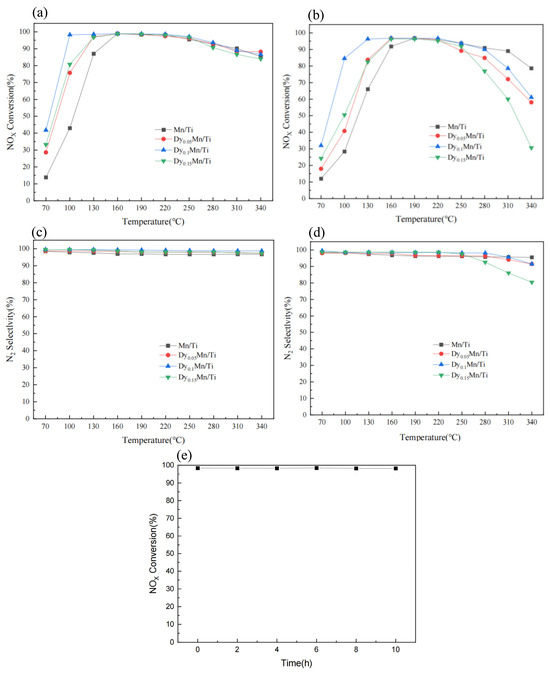
Figure 1.
Effect of Dy/Mn molar ratio on NOx conversion (a,b) and N2 selectivity at different space velocities (24,000 h−1, 48,000 h−1) (c,d); results of Dy0.1Mn/TiO2 catalyst stability testing (e).
Simultaneously, the series of prepared catalysts demonstrate notable catalytic activity within the Space velocity range of 24,000 h−1 to 48,000 h−1, indicating their broad operational flexibility in catalytic reactions and making them highly suitable for industrial application. Figure 1c,d display the N2 selectivity of DyxMn/TiO2 catalyst samples when the space velocity is 24,000 h−1 and 48,000 h−1, respectively, ensuring an N2 selectivity of over 95% below 240 °C. At elevated space velocities, when the temperature exceeds 260 °C, the selectivity decreases due to an increased likelihood of side reactions and a reduced contact time and chance between gas and catalyst, primarily attributed to the excessive space velocity. In summary, when the molar ratio of Dy/Ti is 0.1, the DyxMn/TiO2 catalyst sample exhibits the best low-temperature SCR denitrification performance and outstanding N2 selectivity. Lastly, the stability of the Dy0.1Mn/TiO2 catalyst sample was tested at 150 °C. As shown in Figure 1e, the catalytic efficiency of the Dy0.1Mn/TiO2 catalyst sample consistently remained above 98% throughout the entire test period, demonstrating the catalyst’s exceptional stability.
2.2. SEM, Crystallinity, and Porous Property Analyses
Figure 2 displays the SEM images of the Mn/TiO2 catalyst and the DyxMn/TiO2 catalyst. As the molar ratio of Dy increases, the active components on the catalyst surface gradually increase, as evident from Figure 2. However, the surface of the Dy0.15Mn/TiO2 catalyst exhibited noticeable agglomeration, leading to a decrease in the catalyst’s specific surface area. Concurrently, this phenomenon obscured the active sites on the surface to some extent, ultimately diminishing the catalyst’s SCR catalytic activity. As shown in Figure 2c, the Dy0.1Mn/TiO2 catalyst boasts a considerable amount of active components uniformly distributed across its surface, thereby manifesting commendable catalytic activity in SCR catalytic performance experiments.
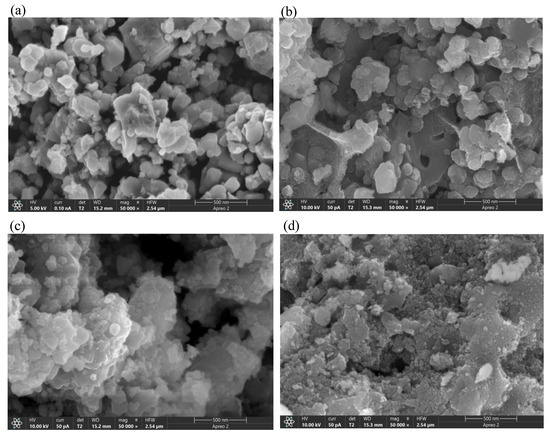
Figure 2.
SEM microstructures of the different catalysts. (a) Surface morphology of Mn/TiO2. (b) Surface morphology of Dy0.5Mn/TiO2. (c) Surface morphology of Dy0.1Mn/TiO2. (d) Surface morphology of Dy0.15Mn/TiO2.
Figure 3 displays the XRD patterns of the DyxMn/TiO2 catalyst. All catalysts exhibited comparable XRD diffraction peaks, suggesting that the addition of the rare-earth metal Dy did not alter the crystal structure of the catalyst. Characteristic peaks of anatase TiO2 were observed at 25.8°, 38.0°, 47.6°, 54.5°, 62.8°, 69.5°, and 75.2°. Anatase TiO2 is more beneficial for enhancing the catalytic performance of SCR [35]. As shown in Figure 3, no characteristic peaks of Mn and Dy oxides were observed on the surface of the catalyst sample. This suggests that the oxides of Mn and Dy are either highly dispersed on the surface of the catalyst or exist in an amorphous form, which cannot be detected by XRD [39]. Upon the introduction of the rare-earth metal Dy, as the Dy/Ti molar ratio increases, the diffraction peak intensity exhibits a trend of initial decrease, subsequent increase, and subsequent decrease. The introduction of Dy into the system indicates a reduction in the crystallinity of the TiO2 support. Table 1 presents the ICP–OES analysis of catalysts. The results indicate that the actual loading mass of Dy in each catalyst essentially aligns with the theoretical value. It also demonstrates that the prepared catalyst does indeed contain a specific amount of Mn and Dy oxides, which to some extent corroborates the XRD data analysis.
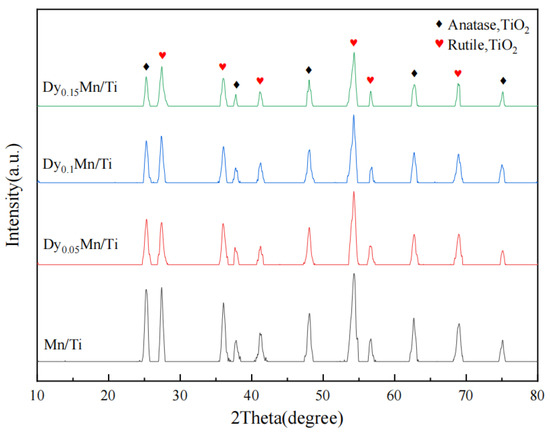
Figure 3.
XRD patterns of the different catalysts.

Table 1.
Mass fraction of the DyxMn/TiO2 catalysts measured with ICP–OES.
Figure 4 depicts the adsorption–desorption isotherms of all catalysts. The catalysts exhibit type IV isotherms and type H2 hysteresis loops, which are hallmarks of mesoporous materials. The measurement and calculation of specific surface area, pore volume, and pore diameter are based on BET and BJH equations, as detailed in Table 2 below. The specific surface area of the Mn/TiO2 catalyst is only 7.94 m2/g. With the introduction of Dy, the specific surface area initially increases and then decreases. The pore volume becomes larger but the pore size becomes smaller. The specific surface area of the Dy0.1Mn/TiO2 catalyst is as high as 49.47 m2/g, which is higher than 37.01 m2/g in the literature [39]. The large surface area of the catalyst facilitates the rapid adsorption of reactants and the desorption of products on the catalyst surface, thereby enhancing the low-temperature SCR catalytic performance of the catalyst [38]. The results indicate that the specific surface area of the catalyst and the gas–solid contact area of the catalytic reaction can be significantly increased when an appropriate amount of the rare-earth metal Dy is introduced, which also enhances the SCR denitrification activity of the catalyst.
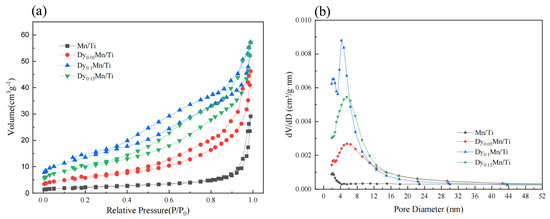
Figure 4.
(a) Nitrogen adsorption-esorption curve of the different catalysts. (b) Pore size distribution curve of the different catalysts.

Table 2.
The pore analysis data of the different catalysts.
2.3. XPS Analysis
Figure 5 displays the X-ray photoelectron spectroscopy (XPS) characterization of the DyxMn/TiO2 catalyst, aiming to investigate the variations in elemental valence on the surface of various catalysts. It involves the separation and fitting of characteristic peaks for Mn, O, and Dy elements in each catalyst, and the computation of the relative concentrations of Mn, O, and Dy elements in varying valence states on the surface of each catalyst. As illustrated in Figure 5a, the photoelectron peaks for Mn 2p3/2 and Mn 2p1/2 are situated around 642.0 eV and 653.5 eV, respectively. Mn 2p3/2 was categorized into three electronic peaks, namely Mn2+ (641.2 ± 0.1 eV), Mn3+ (642.3 ± 0.1 eV), and Mn4+ (643.8 ± 0.1 eV) [38]. According to relevant literature [39], high levels of Mn4+ promote the NH3-SCR catalytic reduction reaction. Table 2 shows that with the addition of the rare-earth metal Dy, the Mn4+/(Mn2+ + Mn3+ + Mn4+) ratio first increases and then decreases. The Dy0.1Mn/TiO2 catalyst exhibits the highest ratio, aligning with the results of the SCR performance test. This aligns with the literature’s conclusion: Mn4+ concentration is a crucial factor in determining the catalyst’s low-temperature catalytic activity.
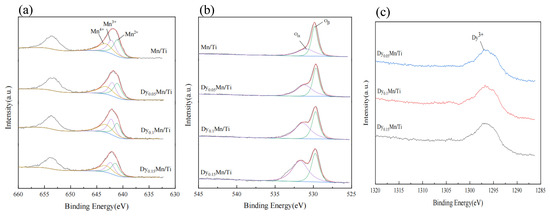
Figure 5.
XPS of the different catalysts: (a) Mn 2p, (b) O 1s, (c) Dy 4d.
As shown in Figure 5b, all catalysts exhibit two overlapping peaks around 529.8 eV and 531.5 eV [38]. The peak at 529.8 eV belongs to lattice oxygen (denoted as Oβ), while the peak at 531.5 eV belongs to adsorbed oxygen (denoted as Oα). According to a literature report [39], Oα has a higher mobility than Oβ. It can be converted to lattice oxygen at oxygen vacancies on the catalyst surface, thereby enhancing the oxidation ability of NO at low temperatures and promoting the rapid progress of the SCR reaction. Table 2 reveals that with the addition of the rare-earth metal Dy, the ratio of Oα/(Oα + Oβ) on the catalyst surface gradually increases. This suggests that the amount of adsorbed oxygen is a pivotal factor influencing the catalyst’s low-temperature catalytic performance. The location of Dy 4d is indicated to be around 1294 eV, as depicted in Figure 5c, which corresponds to the Dy3+ on the catalyst surface.
2.4. H2-TPR, NH3-TPD Analysis
The H2-TPR experiment is conducted to investigate the redox behavior of the DyxMn/TiO2 catalyst. The redox properties of catalysts significantly determine their catalytic properties. As illustrated in Figure 6, all catalysts exhibit two broad, overlapping reduction peaks within the temperature range of 150–550 °C. For the Mn/Ti catalyst, the reduction peak around 359 °C is attributed to the reduction process of MnO2 → Mn2O3 [31,38]. The reduction peak within the temperature range of 420–520 °C is attributed to the reduction process of Mn2O3 → Mn3O4 → MnO [39]. Compared to the peak of Mn/TiO2, the reduction peak of the Dy–Mn/Ti catalyst shifted towards lower temperatures due to the synergistic effect between Dy and Mn/TiO2. Among them, the Dy0.1Mn/TiO2 catalyst and the Dy0.15Mn/TiO2 catalyst exhibit the lowest reduction peak temperatures. The peak performance of the Dy0.1Mn/TiO2 catalyst is notably broader and encompasses regions of lower temperature. Upon calculating the peak area, it is observed that the Dy0.1Mn/TiO2 catalyst boasts the largest peak area, as illustrated in Table 3. The H2-TPR results indicate that the Dy0.1Mn/TiO2 catalyst exhibits the optimal reduction behavior at low temperatures and demonstrates the highest catalytic activity among the SCR catalysts, corroborating the findings from the prior SCR catalytic performance tests.

Figure 6.
H2-TPR analysis of the different catalysts.

Table 3.
The valence concentration of elements on the surface of the different catalysts and H2 reduction peak area.
In the NH3-SCR reaction, the adsorption capacity of the catalyst for NH3 is crucial. Figure 7 shows the NH3-TPD characterization results for all DyxMn/TiO2 catalysts. Three weak desorption peaks can be observed for the Mn/TiO2 catalyst. The peak around 118 °C is attributed to the physical adsorption of NH3 on the catalyst, the peak around 266 °C is attributed to the desorption peak of NH3 adsorbed on the Bronsted acid site (weak acid), and the peak around 351 °C is attributed to the desorption peak of NH3 adsorbed on the Lewis acid site (strong acid) [38]. Upon introduction of the rare-earth metal Dy, the desorption peak on weak acid significantly intensified. As the Dy content increased, the area of the desorption peak initially expanded and then diminished. As illustrated in Table 3, it is observed that the peak area of NH3 desorption for the Dy0.1Mn/TiO2 catalyst is the largest among all catalysts, suggesting the highest number of weak acid sites on the catalyst surface. According to literature reports [38], weak acids are crucial to the low-temperature catalytic activity of catalysts. Consequently, the moderate incorporation of Dy notably enhances the adsorption capacity of NH3 on the catalyst surface, substantially increases the number of weak acid sites on the catalyst surface, and consequently boosts the catalyst’s activity at low temperatures. The results of the NH3-TPD characterization experiments further corroborate and validate the previous results of the NH3-SCR performance tests.
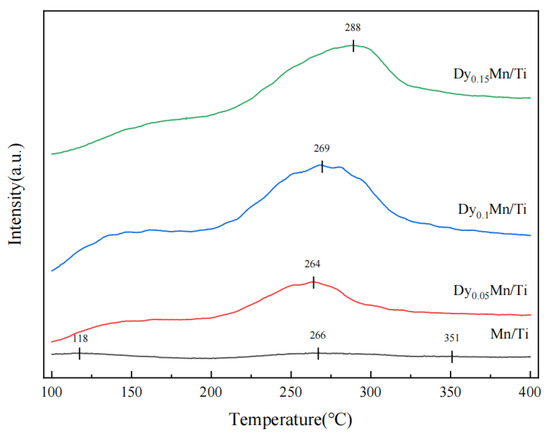
Figure 7.
NH3-TPD analysis of the different catalysts.
3. Experiment
3.1. Synthesis Catalyst
A series of DyMn/TiO2 catalysts with varying Dy/Mn molar ratios were prepared using the impregnation method. The detailed synthesis procedure is as follows: Weigh an appropriate amount of Dysprosium Nitrate (AR, purchased from Shanghai Mcleam Biochemical Technology Co., Ltd., Shanghai, China) and manganese acetate (AR, purchased from Alddin Reagent Co., Ltd., Shanghai, China) into a beaker that holds 50 mL of deionized water. To facilitate dissolution, place the beaker into a magnetic water bath stirring pot and stir thoroughly. Weigh an appropriate amount of titanium dioxide powder (AR, purchased from Sinopharm Chemical Reagent Co., Ltd., Shanghai, China) and add it gradually to the beaker. Stir at room temperature for 2 h, and then raise the temperature to 90 °C using the water bath. Continue stirring until the water evaporates to a viscous state. Then, remove the beaker and dry it in a 110 °C drying oven for 15 h to obtain a dry, block-like solid. Subsequently, transfer the block-shaped solid to a quartz crucible and roast it in a muffle furnace at 400 °C (with a heating rate of 6 °C/min) for four hours in an air atmosphere to yield the calcined solid particles. Finally, make a catalyst powder with a particle diameter ranging from 0.25 to 0.45 mm through tablet pressing, grinding, and sieving to achieve a mesh size of 40–60. The synthesized catalyst series is denoted by the symbol DyxMn/TiO2, where x represents the molar ratio of Dy to Ti (Mn:Ti = 0.3:1; the mass fraction of Dy was 7.02%, 13%, and 18.13%, respectively). Additionally, when x is 0, it corresponds to the Mn/TiO2 catalyst, also prepared via the impregnation method.The reaction mechanism is shown in Figure 8.
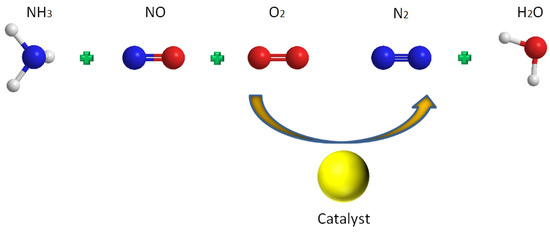
Figure 8.
Main schematic diagram of NH3-SCR denitration.
3.2. Characterization of Catalysts
The phase composition and crystal phase composition of the catalyst were analyzed using an X-ray diffractometer (D8ADVANCE, Bruker Corporation, Bremen, Germany), with cu-k α serving as the radiation source. The tube voltage was set to 40 kV, the tube current to 30 mA, the XRD scanning range to 10–80°, and the step size to 0.02°. A scanning electron microscope (JSM-7610FPlus, JEOL Co., Ltd., Tokyo, Japan) was used to observe the morphology of aerogel under an accelerating voltage of 15 kV. The specific surface area and pore structure of the samples were determined using a specific surface area and pore volume aperture analyzer (ASAP2460, Micromeritics, Norcross, GA, USA). The calculation of test data was performed according to BET analysis. The X-ray photoelectron spectrometer (Escalab 250xi, Thermo Fisher Scientific, Waltham, MA, USA) was employed for the XPS test, with the aim of investigating the valence state of atoms present on the surface of the catalyst. The binding energies of the measured elements were corrected using the C 1s peak (284.6 eV). An analysis was conducted using an Al Kα X-ray with a tube voltage of 1486.6 eV. The content of metal elements in the catalyst was determined by inductively coupled plasma atomic emission spectrometry (ICPOES 730, Aglient Technology Co., Ltd., Santa Clara, CA, USA).
The H2-TPR experiment employed the BELCAT-A system (BELCAT-A, Bayer, Tokyo, Japan) for temperature-programmed reduction, aimed at examining the impact of the catalyst’s redox property on its catalytic performance. Test procedure: Weigh 100 mg of sample and transfer it into a reaction tube. Dry it at a rate of 10 °C/min, increasing from room temperature to 300 °C. Use a high-purity nitrogen flow rate (30 mL/min) to purge it for 1 h, and then allow it to cool down to 50 °C. Convert N2 to a reducing gas (10% H2/N2) for purge purposes, remove any residual N2 on the sample surface and within the pipeline, maintaining a flow rate of 30 mL/min, then increase the temperature from 50 °C to 700 °C at a rate of 10 °C/min. Record the TCD signal value.
The NH3-TPD analysis was also conducted using the BELCAT-A system (BELCAT-A, Bayer, Japan) to investigate the impact of acidity on the catalytic performance of the catalyst. Test procedure: Weigh 50–200 mg of sample and transfer it into a reaction tube. Program the temperature to rise to 300 °C at a rate of 10 °C/min for drying pretreatment. Purge it with a N2 flow of 30 mL/min for 1 h and cool it to 50 °C. Subsequently, introduce a 10% NH3/N2 mixture (30 mL/min) and leave it to saturate for an hour. Afterward, switch on the flow of N2 (30 mL/min) to purge for an hour and remove any weakly physically adsorbed NH3 on the surface. Finally, under an N2 atmosphere, raise the temperature at a rate of 10 °C/minute until it reaches 600 °C for desorption. The desorbed gas is detected using a thermal conductivity detector (TCD).
3.3. Characterization of Catalysts
The laboratory self-made denitration activity evaluation equipment is the experimental device employed for the NH3-SCR performance test of the experimental catalyst (Figure 9). The reactor has an inner diameter of 1 cm and a length of 50 cm. The center of the reaction tube is filled with 0.096 g of catalyst, and the temperature of the reactor is monitored using a thermocouple. During the reaction process, the temperature is maintained between 100–400 °C. For every 30 °C increase, the temperature is held for approximately 20 min to stabilize the concentration of each tail gas component. Real-time data are recorded sequentially. Rotor flowmeters and volume flowmeters are utilized to harmoniously regulate the flow of gases from each pathway, stabilizing the overall flow rate of the simulated flue gas atmosphere. Additionally, the gas volume space velocity is adjusted to 24,000 h−1 (Flow rate is 300 mL/min) and 48,000 h−1, respectively. An online flue gas analyzer (GW-2000) is employed to monitor the NOx content in the reactor’s exhaust, a nitrous oxide detector (FGD2-C-N2O) is utilized to measure the N2O level in the reaction’s exhaust, and a specific length gas detection tube is used to determine the concentration of ammonia in both the intake air and the exhaust.
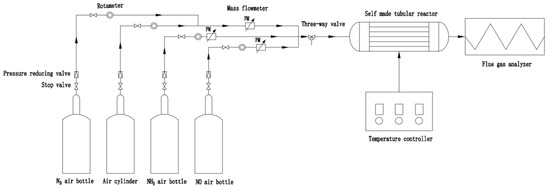
Figure 9.
Flow chart of catalyst performance test device.
4. Conclusions
An efficient Mn/TiO2 catalyst, prepared through modification with the rare-earth metal Dy, has been employed for low-temperature selective catalytic reduction (SCR) denitrification. The DyxMn/TiO2 catalyst, prepared by the impregnation method, exhibited outstanding catalytic performance. Experiments and characterization revealed that the introduction of a suitable amount of the rare-earth metal Dy can effectively enhance the specific surface area of the catalyst and increase the contact area for gas–solid reactions. Concurrently, the incorporation of the rare-earth metal Dy significantly enhances the concentration of Mn4+ on the catalyst surface and the chemisorption of oxygen, significantly contributing to the improvement of the catalyst’s activity. Lastly, the SCR catalytic performance was confirmed through NH3-TPD and H2-TPR experiments. The findings indicate that the incorporation of a suitable amount of the metal Dy significantly enhances the adsorption capacity of NH3 on the catalyst surface and effectively augments the number of weak acid sites on the catalyst surface, thereby enhancing the catalyst’s activity at low temperatures, ameliorating the reduction performance of the DyMn/TiO2 catalyst, and ultimately bolstering the performance of NH3-SCR denitration at low temperatures. The Dy0.1Mn/TiO2 catalyst can achieve a 98% NOx conversion rate at 100 °C under a space velocity of 24,000 h−1. Additionally, its active temperature point is 60 °C lower than before modification, demonstrating an outstanding catalytic performance at low temperatures. After doubling the space velocity, the NOx conversion of the catalyst remains at 96% even at 130 °C, demonstrating substantial operational flexibility. The selectivity to N2 remains above 95% up to 240 °C.
Author Contributions
Investigation: B.X., Z.W., J.H., L.Z., Z.Z., H.L., Y.Z. and G.F.; original manuscript writing: B.X. and Z.W.; manuscript review: B.X., J.H. and L.Z. All authors have read and agreed to the published version of the manuscript.
Funding
This research was supported by the financial assistance provided by the Key Project of the Scientific Research Program of the Hubei Provincial Department of Education (D20201602) and the Hubei Natural Science Foundation (2023AFB385).
Institutional Review Board Statement
The study was conducted in the laboratory of the Hubei Provincial Engineering Technology Research Center of Agricultural and Sideline Resources Chemical Engineering and Utilization, School of Chemistry and Environmental Engineering, Wuhan Polytechnic University and approved by the Institutional Review Board, 2023.
Informed Consent Statement
Not applicable.
Data Availability Statement
The data presented in this study are available on request from the corresponding author.
Acknowledgments
The authors express their gratitude to the laboratory of the Hubei Provincial Engineering Technology Research Center of Agricultural and Sideline Resources Chemical Engineering and Utilization, School of Chemistry and Environmental Engineering, Wuhan Polytechnic University, in whose laboratories the study was carried out.
Conflicts of Interest
The authors declare no conflict of interest.
References
- Li, Y.; Leng, X.; Ma, S.; Zhang, T.; Yuan, F.; Niu, X.; Zhu, Y. Effects of Mo addition on the NH3-SCR of NO reaction over Moa MnTi10Ox (a = 0.2, 0.4, 0.6 and 0.8): Synergistic action between redox and acidity. Catal. Today 2020, 339, 254–264. [Google Scholar] [CrossRef]
- Zhou, J.; Guo, R.; Zhang, X.; Liu, Y.; Pan, W. Cerium oxide—Based catalysts for low-temperature selective catalytic reduction of NOx with NH3: A review. Energ. Fuel 2021, 35, 2981–2998. [Google Scholar] [CrossRef]
- Xie, H.; He, P.; Chen, C.; Yang, C.; Chai, S.; Wang, N.; Ge, C. Improvement of Sb-Modified Mn-Ce/TiO2 Catalyst for SO2 and H2O Resistance at Low-Temperature SCR. Catal. Lett. 2023, 153, 2838–2852. [Google Scholar]
- Jiang, H.; Wang, H.; Kuang, L.; Li, G.; Zhang, M. Synthesis of MnOx–CeO2·NOx catalysts by polyvinyl pyrrolidone–assisted supercritical antisolvent precipitation. J. Mater. Res. 2014, 29, 2188–2197. [Google Scholar] [CrossRef]
- Kapteijn, F.; Singoredjo, L.; Andreini, A.; Moulijn, J.A. Activity and selectivity of pure manganese oxides in the selective catalytic reduction of nitric oxide with ammonia. Appl. Catal. B-Environ. 1994, 3, 173–189. [Google Scholar] [CrossRef]
- Dimitrios, K.P.; Pappas, A.; Thirupathi, B.; Punit, B.; Panagiotis, G.S. Novel manganese oxide confined interweaved titania nanotubes for the low-temperature Selective Catalytic Reduction (SCR) of NOx by NH3—ScienceDirect. J. Catal. 2016, 334, 1–13. [Google Scholar]
- Yang, S.; Qi, F.; Liao, Y.; Xiong, S.; Lan, Y.; Shan, W.; Li, J. Dual effect of sulfation on the selective catalytic reduction of NO with NH3 over MnOx/TiO2: Key factor of NH3 distribution. Ind. Eng. Chem. Res. 2014, 53, 5810–5819. [Google Scholar] [CrossRef]
- Yang, S.; Qi, F.; Xiong, S.; Dang, H.; Liao, Y.; Wong, P.; Li, J. MnOx supported on Fe-Ti spinel: Anovel Mn based low temperature SCR catalyst with a high N2 selectivity. Appl. Catal. B.-Environ. 2016, 181, 570–580. [Google Scholar] [CrossRef]
- Zhang, B.; Zhang, S.; Liu, B. Comparative study on transition element doped Mn-Zr-Ti-oxides catalysts for the low-temperature selective catalytic reduction of NO with NH3. React. Kinet. Mech. Catal. 2019, 127, 637–652. [Google Scholar] [CrossRef]
- Zhang, B.; Liebau, M.; Suprun, W.; Liu, B.; Zhang, S.; Glaeser, R. Suppression of N2O formation by H2O and SO2 in the selective catalytic reduction of NO with NH3 over a Mn/Ti-Si catalyst. Catal. Sci. Technol. 2019, 9, 4759–4770. [Google Scholar] [CrossRef]
- Qiu, L.; Wang, Y.; Pang, D.; Feng, O.; Zhang, C.; Cao, G. Characterization and catalytic activity of Mn–Co/TiO2 catalysts for NO oxidation to NO2 at low temperature. Catalysis 2016, 6, 9. [Google Scholar] [CrossRef]
- Qiu, L.; Meng, J.; Pang, D.; Zhang, C.; Ouyang, F. Reaction and characterization of Co and Ce doped Mn/TiO2 catalysts for low-temperature SCR of NO with NH3. Cawal. Lett. 2015, 145, 1500–1509. [Google Scholar] [CrossRef]
- Qiu, L.; Pang, D.; Zhang, C.; Meng, J.; Zhu, R.; Ouyang, F. In situ IR studies of Co and Ce doped Mn/TiO2 catalyst for low-temperature selective catalytic reduction of NO with NH3. Appl. Surf. Sci. 2015, 357, 189–196. [Google Scholar] [CrossRef]
- Guan, B.; Zhan, R.; Lin, H.; Huang, Z. Review of State of the Art Technologies of Selective Catalytic Reduction of NOx from Diesel Engine Exhaust. Appl. Therm. Eng. 2014, 66, 395–414. [Google Scholar] [CrossRef]
- Liu, L.; Su, S.; Xu, K.; Li, H.; Qing, M.; Hu, S.; Wang, Y.; Xiang, J. Insights into the highly efficient Co modified MnSm/Ti catalyst for selective catalytic reduction of NO with NH3 at low temperature. Fuel 2019, 255, 115798. [Google Scholar] [CrossRef]
- De La Torre, U.; Pereda-Ayo, B.; González-Marcos, J.A.; Gutiérrez-Ortiz, M.A.; González-Velasco, J.R. Performance of Cu-ZSM-5 in a coupled monolith NSR-SCR system for NOx removal in lean-burn engine exhaust. Top. Catal. 2016, 59, 259–267. [Google Scholar] [CrossRef]
- Zhang, M.; Cao, H.; Chen, Y.; Jiang, H. Role of Mn: Promotion of fast-SCR for Cu-SAPO-34 in low-temperature selective catalytic reduction with ammonia. Catal. Surv. Asia 2019, 23, 245–255. [Google Scholar] [CrossRef]
- Liu, X.; Zhao, Z.; Ning, R.; Qin, Y.; Zhu, T.; Liu, F. Ce-Doped V2O5-WO3/TiO2 with low vanadium loadings as SCR catalysts and the resistance of H2O and SO2. Catal. Lett. 2019, 150, 375–383. [Google Scholar] [CrossRef]
- Gao, Y.; Jiang, W.; Luan, T.; Li, H.; Zhang, W.; Feng, W.; Jiang, H. High-efficiency catalytic conversion of NOx by the synergy of nanocatalyst and plasma: Effect of Mn-based bimetallic active species. Catalysts 2019, 9, 103. [Google Scholar] [CrossRef]
- Sun, P.; Guo, R.; Liu, S.; Wang, S.; Pan, W.; Li, M. The enhanced performance of MnOx catalyst for NH3-SCR reaction by the modification with Eu. Appl. Catal. A-Gen. 2017, 531, 129–138. [Google Scholar] [CrossRef]
- Gao, F.; Tang, X.; Yi, H.; Li, J.; Zhao, S.; Wang, J.; Chu, C.; Li, C. Promotional mechanisms of activity and SO2 tolerance of Co- or Ni-doped MnOx-CeO2 catalysts for SCR of NOx with NH3 at low temperature. Chem. Eng. J. 2017, 317, 20–31. [Google Scholar] [CrossRef]
- Gao, Y.; Luan, T.; Zhang, M.; Zhang, W.; Feng, W. Structure-activity relationship study of Mn/Fe ratio effects on Mn-Fe-Ce-Ox/γ-Al2O3 nanocatalyst for NO oxidation and fast SCR reaction. Catalysts 2018, 8, 642. [Google Scholar] [CrossRef]
- Liu, Z.; Chen, C.; Zhao, J.; Yang, L.; Sun, K.; Zeng, L.; Pan, Y.; Liu, Y.; Liu, C. Study on the NO2 production pathways and the role of NO2 in fast selective catalytic reduction DeNOx at low-temperature over MnOx/TiO2 catalyst. Chem. Eng. J. 2020, 379, 122288. [Google Scholar] [CrossRef]
- Li, W.; Zhang, C.; Li, X.; Tan, P.; Zhou, A.; Fang, Q.; Chen, G. Ho-modified Mn-Ce/TiO2 for low-temperature SCR of NO with NH3: Evaluation and characterization. Chin. J. Catal. 2018, 39, 1653–1663. [Google Scholar] [CrossRef]
- Zhang, T.; Ma, S.; Chen, L.; Li, R.; Leng, X.; Li, Y.; Yuan, F.; Niu, X.; Zhu, Y. Effect of Cu doping on the SCR activity over the CumCe0.1−mTiOx (m = 0.01, 0.02 and 0.03) catalysts. Appl. Catal. A-Gen. 2019, 570, 251–261. [Google Scholar] [CrossRef]
- Wang, S.; Guo, R.; Pan, W.; Li, M.; Sun, P.; Liu, S.; Liu, S.; Sun, X.; Liu, J. The deactivation mechanism of Pb on the Ce/TiO2 catalyst for the selective catalytic reduction of NOx with NH3: TPD and DRIFT studies. Phys. Chem. Chem. Phys. 2017, 19, 5333–5342. [Google Scholar] [CrossRef] [PubMed]
- Yu, Z.; Xu, L.; Liang, Z.; Wang, Z. Doping and immobilization of TiO2 with element Na and raschig rings. Chem. Phys. Lett. 2019, 732, 136634. [Google Scholar]
- Fan, Z.; Shi, J.; Gao, C.; Gao, G.; Wang, B.; Wang, Y.; He, C.; Niu, C. Gd-modified MnOx for the selective catalytic reduction of NO by NH3: The promoting effect of Gd on the catalytic performance and sulfuresistance. Chem. Eng. J. 2018, 348, 820–830. [Google Scholar] [CrossRef]
- Xu, Q.; Su, R.; Cao, L.; Li, Y.; Yang, C.; Luo, Y.; Street, J.; Jiao, P.; Cai, L. Facile preparation of high-performance Fe-doped Ce-Mn/TiO2 catalysts for the low-temperature selective catalytic reduction of NOx with NH3. RSC Adv. 2017, 7, 48785–48792. [Google Scholar] [CrossRef]
- Li, Y.; Li, Y.; Shi, Q.; Qiu, M.; Zhan, S. Novel hollow microspheres Mnx Co3−x O4 (x = 1, 2) with remarkable performance for low-temperature selective catalytic reduction of NO with NH3. J. Sol.-Gel. Sci. Technol. 2017, 81, 576–585. [Google Scholar] [CrossRef]
- Qi, G.; Yang, R.T.; Chang, R. MnOx—CeO2 mixed oxides prepared by co-precipitation for selective catalytic reduction of NO with NH3 at low temperatures. Appl. Catal. B-Environ. 2004, 51, 93–106. [Google Scholar] [CrossRef]
- Tang, X.; Hao, J.; Yi, H.; Li, J. Low Temperature SCR of NO with NH3 over AC/C supported manganese-based monolithic catalysts. Catal. Today 2007, 126, 406–411. [Google Scholar] [CrossRef]
- Cheng, K.; Liu, J.; Zhang, T.; Li, J.; Duan, A. Effect of Ce doping of TiO2 support on NH3–SCR activity over V2O5-WO3/CeO2-TiO2 catalyst. J. Environ. Sci. 2014, 26, 2106–2113. [Google Scholar] [CrossRef]
- Jing, W.; Guo, Q.; Hou, Y.; Ma, G.; Han, X.; Huang, Z. Catalytic role of vanadium(V) sulfate on activated Carbon for SO2 oxidation and NH3–SCR of NO at low temperatures. Catal. Commun. 2014, 56, 23–26. [Google Scholar] [CrossRef]
- Liu, Z.; Zhang, S.; Li, J.; Zhu, J.; Ma, L. Novel V2O5–CeO2/TiO2 catalyst with low vanadium loading for the selective catalytic reduction of NOx by NH3. Appl. Catal. B-Environ. 2014, 158–159, 11–19. [Google Scholar] [CrossRef]
- Yang, S.; Xiong, S.; Liao, Y.; Xiao, X.; Qi, F.; Peng, Y.; Fu, Y.; Shan, W.; Li, J. Mechanism of N2O Formation during the Low–Temperature Selective Catalytic Reduction of NO with NH3 over Mn-Fe Spinel. Environ. Sci. Technol. 2014, 48, 10354–10362. [Google Scholar] [CrossRef] [PubMed]
- Wang, J.; Yan, Z.; Liu, L.; Chen, Y.; Wang, X. In Situ DRIFTS Investigation on the SCR of NO with NH3 over V2O5 Catalyst Supported by Activated Semi-Coke. Appl. Surf. Sci. 2014, 313, 660–669. [Google Scholar] [CrossRef]
- Niu, C.; Wang, B.; Xing, Y.; Su, W.; He, C.; Xiao, L.; Xu, Y.; Zhao, S.; Cheng, Y.; Shi, J. Thulium modifified MnOx/TiO2 catalyst for the low-temperature selective catalytic reduction of NO with ammonia. J. Clean. Prod. 2021, 290, 125858. [Google Scholar] [CrossRef]
- Zhang, Y.; Wu, P.; Li, G.; Zhuang, K.; Shen, K.; Wang, S.; Huang, T. Improved activity of Ho-modified Mn/Ti catalysts for the selective catalytic reduction of NO with NH3. Environ. Sci. Pollut. Res. 2020, 27, 26954–26964. [Google Scholar] [CrossRef]
Disclaimer/Publisher’s Note: The statements, opinions and data contained in all publications are solely those of the individual author(s) and contributor(s) and not of MDPI and/or the editor(s). MDPI and/or the editor(s) disclaim responsibility for any injury to people or property resulting from any ideas, methods, instructions or products referred to in the content. |
© 2024 by the authors. Licensee MDPI, Basel, Switzerland. This article is an open access article distributed under the terms and conditions of the Creative Commons Attribution (CC BY) license (https://creativecommons.org/licenses/by/4.0/).